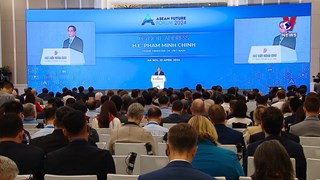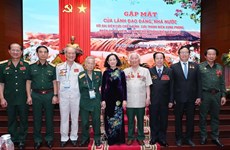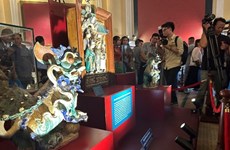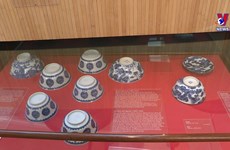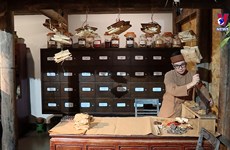Centre seeks to document Hue decorative verses
The Hue Monuments Preservation Centre is currently gathering decorative
verses from royal buildings for which to seek UNESCO World Documentary
Heritage recognition.
The Hue Monuments Preservation Centre is currently gathering decorative
verses from royal buildings for which to seek UNESCO World Documentary
Heritage recognition.
The centre has discovered around 4,000 Chinese and Vietnamese poems carved onto roofs, pillars and decorative patterns dating from the Nguyen dynasty (1802-1945).
Initial work started in the early 1990s, lead by Professor Huynh Minh Duc and his students, who copied and translated Chinese verses found on the roof of the Ngo Mon (Noon Gate) and Thai Hoa Palace .
Their first book was published in 1994 by the Tre (Youth) Publishing House and featured 300 poems and carved phrases as well as single characters from the two architectural works, which lie on the north-south axis of the inner citadel.
The Thai Hoa Palace was the most important architectural work in the royal citadel, having witnessed countless royal events during the golden age of the imperial capital, while the Ngo Mon Gate was reserved for royal members going in and out of the compound.
In order to translate and paraphrase the verses, Prof Duc mobilised much of his own knowledge on Oriental culture.
The Thai Hoa Palace carvings were done on ceramics outside and wood on the inside, They included almost 300 Chinese characters and 200 poems expressing the philosophies of the kings.
According to researcher Phan Thuan An, various historical stories were incorporated from China based on the desire for a prosperous country, intelligent kings and loyal subjects.
Researchers said the project of copying and translating the characters, verses and poems into digital file format could take up to four years.
In April last year, 82 steles from the Le and Mac dynasties (1442-1779) at Hanoi 's Temple of Literature were designated as part of World Documentary Heritage by UNESCO.
The organisation's Memory of the World Programme is an international initiative launched to safeguard the documentary heritage of humanity against collective amnesia, neglect, the ravages of time and climatic conditions, and wilful and deliberate destruction.
It calls for the preservation of valuable archival holdings, library collections and private individual compendia all over the world for posterity, the reconstitution of dispersed or displaced documentary heritage, and the increased accessibility to and dissemination of these items./.
The centre has discovered around 4,000 Chinese and Vietnamese poems carved onto roofs, pillars and decorative patterns dating from the Nguyen dynasty (1802-1945).
Initial work started in the early 1990s, lead by Professor Huynh Minh Duc and his students, who copied and translated Chinese verses found on the roof of the Ngo Mon (Noon Gate) and Thai Hoa Palace .
Their first book was published in 1994 by the Tre (Youth) Publishing House and featured 300 poems and carved phrases as well as single characters from the two architectural works, which lie on the north-south axis of the inner citadel.
The Thai Hoa Palace was the most important architectural work in the royal citadel, having witnessed countless royal events during the golden age of the imperial capital, while the Ngo Mon Gate was reserved for royal members going in and out of the compound.
In order to translate and paraphrase the verses, Prof Duc mobilised much of his own knowledge on Oriental culture.
The Thai Hoa Palace carvings were done on ceramics outside and wood on the inside, They included almost 300 Chinese characters and 200 poems expressing the philosophies of the kings.
According to researcher Phan Thuan An, various historical stories were incorporated from China based on the desire for a prosperous country, intelligent kings and loyal subjects.
Researchers said the project of copying and translating the characters, verses and poems into digital file format could take up to four years.
In April last year, 82 steles from the Le and Mac dynasties (1442-1779) at Hanoi 's Temple of Literature were designated as part of World Documentary Heritage by UNESCO.
The organisation's Memory of the World Programme is an international initiative launched to safeguard the documentary heritage of humanity against collective amnesia, neglect, the ravages of time and climatic conditions, and wilful and deliberate destruction.
It calls for the preservation of valuable archival holdings, library collections and private individual compendia all over the world for posterity, the reconstitution of dispersed or displaced documentary heritage, and the increased accessibility to and dissemination of these items./.
